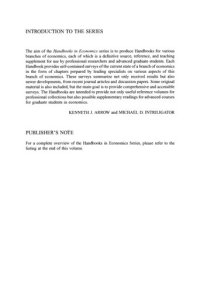
Ebook: Handbook of Income Distribution
- Series: Handbooks in Economics): Volume 1 (Handbook of Income Distribution Volume 1, 1
- Year: 2000
- Publisher: North Holland
- Edition: Illustrated
- Language: English
- djvu
Economists have responded quickly to the renewed general interest in distribution, and the contents of this Handbook are very different from those which would have been included had it been written ten or twenty years ago. It has now become common to have income distribution variables playing a pivotal role in economic models. The recent interest in the relationship between growth and distribution is a good example of this. The surge of political economy in the contemporary literature is also a route by which distribution is coming to re-occupy the place it deserves. Within economics itself, the development of models of imperfect information and informational asymmetries have not only provided a means of resolving the puzzle as to why identical workers get paid different amounts, but have also caused reconsideration of the efficiency of market outcomes. These models indicate that there may not necessarily be an efficiency/equity trade-off; it may be possible to make progress on both fronts.
The introduction and subsequent 14 chapters of this Handbook cover in detail all these new developments, insisting at the same time on how they tie with the previous literature on income distribution. The overall perspective is intentionally broad. As with landscapes, adopting various points of view on a given issue may often be the only way of perceiving its essence or reality. Accordingly, income distribution issues in the various chapters of this volume are considered under their theoretical or their empirical side, under a normative or a positive angle, in connection with redistribution policy, in a micro or macro-economic context, in different institutional settings, at various point of space, in a historical or contemporaneous perspective. Specialized readers will go directly to the chapter dealing with the issue or using the approach they are interested in. For them, this Handbook will be a clear and sure reference. To more patient readers who will go through various chapters of this volume, this Handbook should provide the multi-faceted view that seems necessary for a deep understanding of most issues in the field of distribution.
For more information on the Handbooks in Economics series, please see our home page on http://www.elsevier.nl/locate/hes